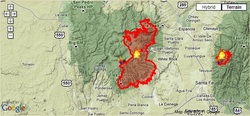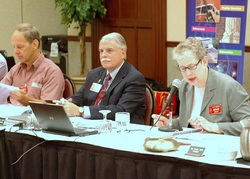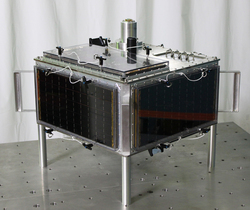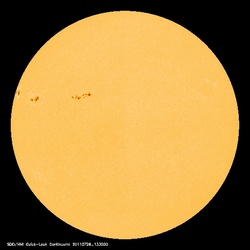 July 28, 2011 John E. Ross, KD8IDJ, Editor
| ||||||||
+ Available on ARRL Audio News + Public Service: New Mexico Hams Provide Communications Support During Wildfires
One month after it began, the Las Conchas Fire -- New Mexico's largest fire on record -- has burned more than 157,000 acres and is 90 percent contained. One day after it started, the fire threatened the Los Alamos National Laboratory, forcing the evacuation of the entire town of Los Alamos. During the evacuation, the Santa Fe ARES® Group placed itself on alert. The fire, which began on June 26, is believed to have been human set. Read more here. + ARRL Board of Directors Gathers in Connecticut for 2011 Second Meeting
The ARRL Board of Directors held its Second Meeting of 2011 July 15-16 in Windsor, Connecticut, under the chairmanship of President Kay Craigie, N3KN. At the two-day meeting, the Board considered a number of reports and acted on several recommendations -- including proceeding with plans for a digital version of QST and planning for the League's Centennial Celebration in 2014 -- and Directors' motions. The ARRL Board of Directors meets twice each year -- in January and July -- usually in the Hartford area. Click here for a detailed look at the 2011 Second Meeting of the ARRL Board of Directors. FCC News: ARRL Asks FCC to Keep 2300 MHz Proceeding Open
In June, the FCC released a Public Notice that sought comments on whether or not it should terminate approximately 800 docketed proceedings in the Wireless Telecommunications Bureau, the International Bureau, the Office of Engineering and Technology and the Enforcement Bureau. Some of the proceedings set for possible termination affect the Amateur Radio Service. On July 20, the ARRL filed comments with the FCC on this matter, explaining that it has no objection to the termination of the proceedings in the Public Notice, save for one item. "With respect to the Office of Engineering and Technology dockets slated for termination," the ARRL stated in its comments, "there is one Amateur Radio-related proceeding that, in the ARRL's view, should not be terminated, but retained in open status." Read more here. + Amateur Radio in Space: Astronauts On Board ISS Get ARISSat-1 Ready for Launch
The ARISSat-1 satellite -- also known as KEDR -- has spent several months aboard the International Space Station waiting for deployment by crew. According to the AMSAT News Service, that day is arriving soon. "As of July 22, we are looking at an August 3, 2011 date for EVA 29 and the ARISSat-1/KEDR deployment, subject to change due to ISS schedules," said ARISSat-1/KEDR Project Manager Gould Smith, WA4SXM. "The preliminary Russian EVA-29 timeline shows the ARISSat/KEDR deployment is the first task of the EVA, so it will occur fairly soon after the EVA begins." The ARISSat-1/KEDR battery was charged for 24 hours on July 24. A test of the satellite inside the ISS is scheduled to run from 1900 UTC on Saturday, July 30 and will be turned off at 1430 UTC on July 31. Read more here. + On the Air: The Bands Heat Up for the 2011 ARRL August UHF Contest
VHF/UHF weak-signal operators across North America are making final tests on their stations in preparation for the 2011 ARRL August UHF Contest, scheduled for the weekend of August 6-7. Most VHF+ SSB/CW operation takes place on the two lowest-frequency bands of the VHF spectrum: 6 and 2 meters. But a lot of activity takes place above 144 MHz in the UHF portion of the radio spectrum and beyond. This contest will focus on 220 MHz and above and there will be lots of activity -- and hopefully lots of propagation, too! Read more here. + On the Air: 2011 ARRL June VHF QSO Party Sets Record for Logs Received The 2011 running of the ARRL June VHF QSO Party saw a record number of logs submitted. This year, 1243 logs were submitted for this contest, breaking the record set in 2010 of 1202 logs. "Six meters has been in excellent shape for the June VHF QSO Party for four of the past five years," explained ARRL Contest Branch Manager Sean Kutzko, KX9X. "It's clear that when the 'Magic Band' is in great shape at the start of the contest, we see more participation with more logs submitted. As a 6 meter fan, I hope this trend continues in the years to come." With the exception of 2007, the ARRL June VHF QSO Party has seen upwards of 1000 logs submitted each year since 2006; in 2007, 860 logs were received, down from 1052 the year before. Kutzko said one of the contributing factors to the popularity of the contest is that more HF transceivers now include the 6 meter band: "When hams buy new HF rigs that include 6 meters, we see them having a go on the band -- sometimes for the first time, other times it's like revisiting an old friend from their past. These hams are having a blast on the band and it sure is contagious. When you add that to the improved propagation, it's no wonder we're seeing an upswing in the popularity of 6 meters." + ARRL Official Observers Team with FCC to Solve Rogue Keyer Problem on 17 Meters
On July 15, Walt Bilous, K3DQB -- an Official Observer in ARRL's Eastern Pennsylvania Section -- notified ARRL Headquarters of a keyer continuously sending a series of dits on 18.0855 MHz. According to ARRL Field and Regulatory Correspondent Chuck Skolaut, K0BOG, Bilous kept hearing the dits throughout the night. Skolaut asked Bilous to alert other OOs to monitor the frequency, but the signal was proving hard to locate via direction finding due to changing propagation and fading conditions on the band. "We alerted OOs across the country to monitor and collect additional information for us including bearings and signal strength reports," Skolaut said. "We had a great response from quite a number of Official Observers." But the signal was still proving elusive, so Skolaut contacted the FCC for assistance. Read more here. Solar Update
Tad "Say my name, Sun shines through the rain" Cook, K7RA, reports: Sunspot activity dipped over this past week, but now is on its way back up. On July 20, five sunspot groups were visible, but on July 21, only groups 1251, 1254 and 1259 remained. On July 24, new sunspot group 1260 appeared, but the next day group 1251 disappeared. On July 26, groups 1254 and 1259 went away, and new sunspot group 1261 arrived. The next day, another new group, 1262, appeared. The average daily sunspot numbers for the week July 21-27 declined nearly 47 points -- a little more than 50 percent -- to 45.6. The average daily solar flux declined more than 6 points to 91.8. The latest forecast shows the predicted solar flux at 100 on July 28-29, rising to 105 on July 30-31, 110 on August 1-3, and then dropping back to 95 on August 4-7. It also shows the planetary A index at 5 on July 28-30, 12 on July 31-August 1, and 7, 5, 8 on August 2-4, followed by 12 again on August 5-7. Geophysical Institute Prague predicts quiet conditions on July 29, quiet to unsettled July 30, unsettled July 31 and August 1, then quiet to unsettled August 2 and quiet again on August 3-4. Look for more information on the ARRL website on Friday, July 29. For more information concerning radio propagation, visit the ARRL Technical Information Service Propagation page. This week's "Tad Cookism" is brought to you by The Bangles' Eternal Flame. + Social Media: ARRL Launches Online Forums To assist League members in communicating with one another and with ARRL staff on topics of common interest, the ARRL has established three forums -- Contesting, Awards and Technology -- on the ARRL website. Visit www.arrl.org/forums to chat with fellow hams about these topics. Additional forums are planned once we have gained some experience with these three. ARRL members, guest users and others can view the threads, but in order to participate in the conversations or ask questions, you must be logged in as an ARRL member. All users should read the forum rules before participating. This Week on the Radio This week:
Next week:
All dates, unless otherwise stated, are UTC. See the ARRL Contest Branch page, the ARRL Contest Update and the WA7BNM Contest Calendar for more information. Looking for a Special Event station? Be sure to check out the ARRL Special Event Stations Web page. Upcoming ARRL Section, State and Division Conventions and Events
To find a convention or hamfest near you, click here. ARRL -- Your One-Stop Resource for Amateur Radio News and Information Join or Renew Today! ARRL membership includes QST, Amateur Radio's most popular and informative journal, delivered to your mailbox each month. Subscribe to NCJ -- the National Contest Journal. Published bi-monthly, features articles by top contesters, letters, hints, statistics, scores, NA Sprint and QSO Parties. Subscribe to QEX -- A Forum for Communications Experimenters. Published bi-monthly, features technical articles, construction projects, columns and other items of interest to radio amateurs and communications professionals. Free of charge to ARRL members: Subscribe to the ARES E-Letter (monthly public service and emergency communications news), the ARRL Contest Update (bi-weekly contest newsletter), Division and Section news alerts -- and much more! Find us on Facebook. Follow us on Twitter. ARRL offers a wide array of products to enhance your enjoyment of Amateur Radio Donate to the fund of your choice -- support programs not funded by member dues! Click here to advertise in this newsletter. | ||||||||















